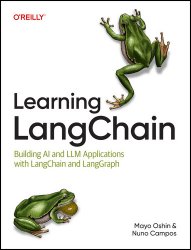Learning LangChain: Building AI and LLM Applications with LangChain and LangGraph (Final Release)
- Добавил: literator
- Дата: 16-02-2025, 05:51
- Комментариев: 0
 Название: Learning LangChain: Building AI and LLM Applications with LangChain and LangGraph (Final Release)
Название: Learning LangChain: Building AI and LLM Applications with LangChain and LangGraph (Final Release)Автор: Mayo Oshin, Nuno Campos
Издательство: O’Reilly Media, Inc.
Год: 2025
Страниц: 349
Язык: английский
Формат: pdf, epub
Размер: 12.2 MB
If you're looking to build production-ready AI applications that can reason and retrieve external data for context-awareness, you'll need to master LangChain—a popular development framework and platform for building, running, and managing agentic applications. LangChain is used by several leading companies, including Zapier, Replit, Databricks, and many more. This guide is an indispensable resource for developers who understand Python or jаvascript but are beginners eager to harness the power of AI.
Authors Mayo Oshin and Nuno Campos demystify the use of LangChain through practical insights and in-depth tutorials. Starting with basic concepts, this book shows you step-by-step how to build a production-ready AI agent that uses your data.
LangChain was one of the earliest open source libraries to provide LLM and prompting building blocks and the tooling to reliably combine them into larger applications. As of writing, LangChain has amassed over 28 million monthly downloads, 99,000 GitHub stars, and the largest developer community in Generative AI (72,000+ strong). It has enabled software engineers who don’t have an ML background to utilize the power of LLMs to build a variety of apps, ranging from AI chatbots to AI agents that can reason and take action responsibly.
LangChain builds on the idea stressed in the preceding section: that prompting techniques are most useful when used together. To make that easier, LangChain provides simple abstractions for each major prompting technique. By abstraction we mean Python and jаvascript functions and classes that encapsulate the ideas of those techniques into easy-to-use wrappers. These abstractions are designed to play well together and to be combined into a larger LLM application.
First of all, LangChain provides integrations with the major LLM providers, both commercial (OpenAI, Anthropic, Google, and more) and open source (Llama, Gemma, and others). These integrations share a common interface, making it very easy to try out new LLMs as they’re announced and letting you avoid being locked-in to a single provider. LangChain also provides prompt template abstractions, which enable you to reuse prompts more than once, separating static text in the prompt from placeholders that will be different for each time you send it to the LLM to get a completion generated. We’ll talk more about these also in Chapter 1. LangChain prompts can also be stored in the LangChain Hub for sharing with teammates. LangChain contains many integrations with third-party services (such as Google Sheets, Wolfram Alpha, Zapier, just to name a few) exposed as tools, which is a standard interface for functions to be used in the tool-calling technique.
Harness the power of retrieval-augmented generation (RAG) to enhance the accuracy of LLMs using external up-to-date data
Develop and deploy AI applications that interact intelligently and contextually with users
Make use of the powerful agent architecture with LangGraph
Integrate and manage third-party APIs and tools to extend the functionality of your AI applications
Monitor, test, and evaluate your AI applications to improve performance
Understand the foundations of LLM app development and how they can be used with LangChain
Скачать Learning LangChain: Building AI and LLM Applications with LangChain and LangGraph (Final Release)
[related-news] [/related-news]
Внимание
Уважаемый посетитель, Вы зашли на сайт как незарегистрированный пользователь.
Мы рекомендуем Вам зарегистрироваться либо войти на сайт под своим именем.
Уважаемый посетитель, Вы зашли на сайт как незарегистрированный пользователь.
Мы рекомендуем Вам зарегистрироваться либо войти на сайт под своим именем.
